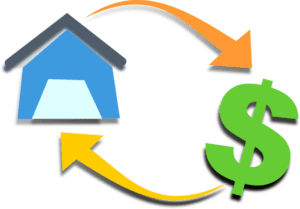Written by: Corey Janoff
This post was originally published on our previous blog website on January 31, 2018 and has since not been revised and/or updated.
A common move that people often assume is financially beneficial is to refinance their mortgage. There are several reasons why people will take this action. People see that either the interest on the new mortgage will be lower, or they can remove Private Mortgage Insurance (PMI) from their original loan, which both result in a lower monthly payment.
Why wouldn’t that be beneficial? If I can get rid of the PMI that is costing me $200/month, that is $200 that can go elsewhere in my life. If I can lower my interest rate, that is less interest that I will pay on my loan. If I can lower my monthly payment, that will obviously save me money.
The problem is twofold. First, people often refinance into a new 30-year loan which extends the amount of time until their current loan will be paid off, resulting in more total payments over the life of the loan. Second, people often don’t apply the saving productively. Let me explain with some examples.
Example 1: Lower Interest Rate
Let’s say you have $400,000 remaining on your mortgage that is five years into a 30-year loan. So you have 25 years remaining. We will pretend the interest on the original loan is at 4.6%. Your current monthly payment (principal plus interest, not including taxes and insurance) is $2,246 per month. Based on your credit and the value of the home, and current interest rates, you can refinance to a new 30-year loan at 4.0%, resulting in a monthly payment of $1,910. These payment amounts are only for the mortgage and do not include taxes or insurance.
If you kept the original loan as is and continue to pay it off over the next 25 years, you will be mortgage debt free in 25 years and the total amount paid from this point forward will be $673,800.
If you choose to refinance to the new 30-year loan at 4.0% and $1,910/month, you won’t be mortgage debt free until 30 years from now (instead of 25) and your total amount paid will be $687,600. This doesn’t include the fees to refinance, which will likely add several thousand dollars to the transaction. So over the life of the loan it is actually costing you almost $14,000 (plus refinancing fees) to refinance.
Now, you might think, what’s the big deal? So it costs me an extra $14,000 over 30 years, but I save $336/month in the process.
That’s great, if you use that $336/month to accelerate your financial goals. For example, if you apply that $336/month towards your new mortgage, the new payment would be the same as you are currently paying and the new loan would be paid off in about 22 and a half years. So you would ultimately be mortgage debt free two and a half years faster than if you stayed on the 4.6% loan that had 25 years remaining.
If you apply that $336 towards your retirement savings and invest in a diversified portfolio that averages a 7% annualized rate of return moving forward, in 25 years you would have an additional $255,000 saved for retirement. If your investments average a 10% annualized rate of return you would have almost $400,000. Even if you only averaged a 4% rate of return, you would have an additional $168,000 in your retirement account. That definitely outweighs the $14,000 of additional costs of extending the loan term.
The problem is, most people don’t apply the monthly difference towards something productive. It gets absorbed into the regular living expenses. They take a nicer vacation, they go out to dinner more often, they hire a housekeeper or sign up for a gym membership.
Bottom line, unless you redirect the monthly savings towards one of your financial goals, all you are doing by refinancing is extending the life of the loan and probably costing yourself money over time.
Example 2: Removing PMI
Maybe we can’t lower our interest rate, but now that we have some equity built up in the home, we can refinance and remove that pesky mortgage insurance (PMI). PMI actually stands for private mortgage insurance, but the “P” might as well stand for “pesky.” It is an additional fee you have to pay on your mortgage if you purchase a house with a less than 20% down payment. There are some exceptions to this rule, but generally, if you buy a home and put less than 20% down, you will be slapped in the face with paying for mortgage insurance each month. Once you have 20% equity in your house (the difference between the appraised value of the home and the outstanding mortgage loan balance), you can get rid of the PMI.
So, let’s say you are five years into your mortgage and have a remaining loan balance of $325,000 at 4.5% interest. Your monthly payment is $1,806 per month plus an additional $200/month for mortgage insurance.
If we can refinance to a new 30-year loan at 4.65% and get rid of the PMI because our house is worth $500,000 now, our new monthly payment is $1,676. The total payment over the life of the loan is $603,360.
If instead of refinancing we kept the original loan with the mortgage insurance on it and our $2,006 monthly payment, we would have the loan paid off in 25 years with a total amount paid of $601,800.
So even though we are removing the $200/month PMI payment and saving $330/month in total, we are still paying a little more over the life of the new loan (partly due to a slightly higher interest rate).
Again, the same principles hold true in this scenario. If we apply the $330 monthly savings towards our financial goals, than it will be productive. If you keep paying $2,006 per month on the new loan, even though the minimum required payment is only $1,676, you would have the new loan paid off in 256 months, or 21 years 4 months. That would make refinancing worthwhile. But if you absorb the savings into your lifestyle expenses, all you are doing is delaying your path to financial independence.
Conclusion
Saving money by refinancing your mortgage isn’t as cut and dry as it appears (or as mortgage people will try to sell you on). Just because the interest rate or the new monthly payment is lower, doesn’t mean you are actually saving money. Only if you apply the monthly savings to something productive will it actually benefit you financially.
The worst is when you refinance a home and pull out equity, resulting in a much larger loan balance. Usually people do this when they want to do some costly home renovations. If you read my blog post last spring, Are Home Renovations Worth It?, you would remember that the additional resale value rarely exceeds the cost of the renovation.
If you are going to pull out equity from your home via a refinance or an equity line of credit, it’s best to pay it off rapidly (ie, less than 24 months) to minimize the interest expense.
So be sure to think long and hard before jumping into a refinance. Run the numbers and make sure it is actually going to help you achieve your financial goals faster. Otherwise you are just giving more money to the banks.
Disclosures:
Any examples are hypothetical and for illustrative purposes only. Any investment can result in losses, including total loss of principal. Consult your financial advisor before making any investment or major financial decisions.




